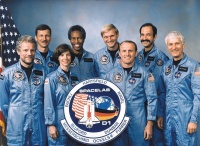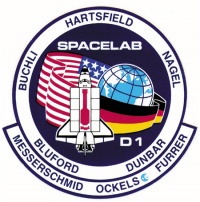STS-61A
From The Space Library
 | |
| Organization | NASA-Office of Space Flight (United States) |
|---|---|
| Mission type | Human Crew |
| Launch date | October 30, 1985 |
| Launch vehicle | Space Shuttle |
| Launch site | Cape Canaveral, United States |
| COSPAR ID | 1985-104A |
| Experiments | Here |
| Alternate Names | STS 22,Spacelab-D1,16230 |
| Additional Information | Here |
| Data Collection | Here |
| Payload Mass Up | 14905.49 kg |
The primary objective of the Spacelab D-1 mission was to conduct basic and applied materials processing research in the Spacelab module funded by DFVLR, and in the Materials Experiment Assembly (MEA) funded by NASA. Life sciences investigations were also conducted in the microgravity environment of space. Approximately 70 investigations were defined covering fluid physics, solidification of crystals and metals, and human and plant cell responses to weightlessness. The NASA MEA supported experiments in vapor crystal growth, immiscible alloy solidification, and containerless processing of glass forming melts. Foreign investigations in the materials science discipline used the following three facilities: a Material Laboratory which included isothermal heating equipment, mirror heating equipment, gradient heating equipment (CNES), a fluid physics module, a cryostat, a high temperature thermostat, and an ultra-high vacuum chamber; the MEDEA structure which included gradient heating equipment with quenching capability, a monoellipsoidal mirror furnace, and a high precision thermostat; and the Process Chamber which included a holographic diagnostic unit, an interdiffusion in salt solutions experiment, and a convection experiment. Most investigators were German; however, there were researchers from France, Italy, the Netherlands, Spain, Switzerland, and the United States. Many of the life sciences investigations were performed using two facilities and some add included a cooler/freezer combination, one incubator for the 18-30 degree C range, a second incubator for the 30-40 C range, and a glove box; and the Vestibular Sled which included the sled unit, the human vestibular system experiment, and the space motion sickness experiment. The single navigation/communications investigation (NAVEX), included a clock synchronization and time distribution experiment, and a one-way distance measurement experiment. The Long Module contained three Spacelab double racks for the materials science facilities and three single racks for life sciences investigations. The crew included NASA mission specialists and two foreign payload specialists. Useful data were collected from almost all investigations. The spacecraft was gravity-gradient stabilized.
Mission patch:

